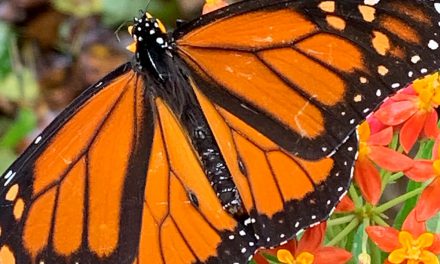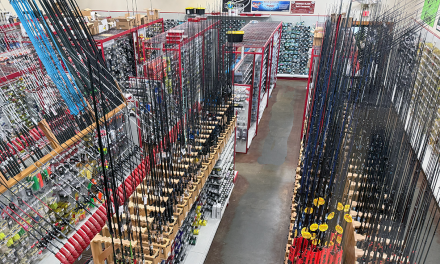Lakeside News’ Senior Reporter Pam Keene continues her adventures around the globe with her latest installment – Marco Polo’s Silk Road, Part 3. The adventure took her to parts of the former Soviet Union where she experienced life in Central Asia beyond her expectations. In this article, she reports about the “real” Silk Road sites on the southwestern part of the country close to the border of Turkmenistan.
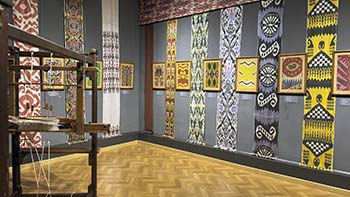
Ikat patterns and color combinations are limitless. The finest are handwoven.
As we traveled from city to town in Uzbekistan, I continued to search for signs of Marco Polo. At last we were leaving the larger cities, heading to Bukhara by train across the arid desert dotted with agricultural areas and the occasional animal herder.
My friend Pat and I eagerly anticipated our arrival in this city of less than 300,000 people. We’d both been asking about Ikat, pronounced EE-kaht, the traditional Central Asian woven fabric that’s dyed in zigzag or geometric patterns. Pat’s familiarity with Ikat piqued my interest as I sought to learn more about the culture of Central Asia.
Basim, our trip leader, had told us that Bukhara would be an excellent place to find a variety of colors and patterns of fabric that can range from cotton to silk. He was correct, and the qualities ranged from very inexpensive for machine-produced cotton to hand-dyed and hand-woven silk. We learned about the traditional dress and fabric in several museums, as well as stores within the bazaar.
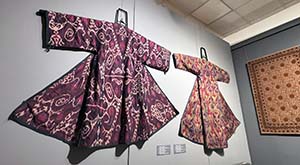
Antique Ikat robes displayed in a museum.
In no time, we both had ordered custom-made clothing in our favorite colors and styles. Pat purchased a beautiful dress; I fell in love with a soft turquoise, gray and white pattern and within 90 minutes the shop’s seamstress had sewed a custom-fitted pair of pants in the latest stove-pipe legs style.
Bukhara’s domed markets still stand from ancient times, and I could almost picture travelers along the Silk Road between China’s capital of Chang’an headed westward for more than 4,000 miles and the Mediterranean Sea. Riding camels, using beasts of burden to haul carts of goods designed, created and grown in the East, travelers and merchants staked their wealth on the success of demand for their products.+
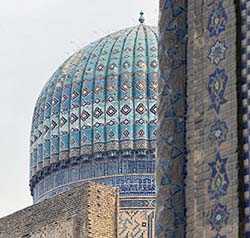
Layers upon layers of stunning mosaic patterns have lasted for centuries.
The skyline of the old city was pierced by a good number of madrasah, mosques and minarets, all decorated with deep blue and turquoise tiles. Ancient landmarks we visited included the famous Ark of Bukhara fortress, built around the 5th century AD. The Samanid Mausoleum, built in the 10th century AD has fascinating intricate brickwork exterior walls.
Traveling overland we headed to Khiva, far and away the most representative of the “real Silk Road.” Surrounded by thick crenelated walls with four main high-arched entrances, the old town’s merchant-lined streets really felt like the real thing.
The old town, a UNESCO World Heritage Site, contains 50 historic monuments, mostly built or restored in the 18th and 19th centuries.
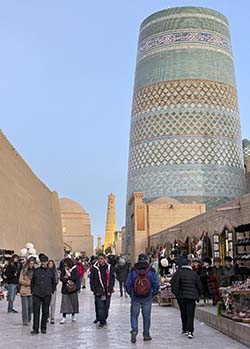
The incomplete Kaltaminor Memorial minaret stands over a street in Khiva.
One of it’s most distinguishing features, a large round, flat-topped Kaltaminor memorial minaret, is among the most distinctive, partly because it is covered in glazed tiles. Built between 1852 and 1855, is incomplete. Construction stopped because its main supporter died in battle. Standing at 90 feet, imagine what it would have looked like had it been completed to its intended 360-foot height.
Lots of trading and bargaining took place on the streets crowded with tables of everything from jewelry and carpets to embroidered textiles and intricate hand-painted miniatures of historic characters, birds and iconic motifs.
Nukus, our last stop on the Silk Road, was by far the most surprising of all, not because of the city itself, but because of the secret it held.
By showing us a documentary, Batir prepared us for what we would find at the Nukus Museum of Art, built in 1966 and named after I.V. Savitsky (1915-1984). Who? You’ll see.
The art graduate, artist and archaeologist began collecting art in secret in the 1950s, not just any art. He amassed Russian Avante-Garde paintings – works that defied the Soviet’s principles because the art was often created to influence sociopolitical viewpoints. Think about family scenes with an inserted portrait of Lenin gazing down from the corner of the work. The message: You are always being watched.”
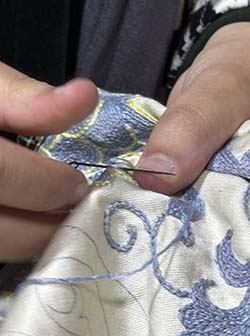
Tedious hand-embroidery with silk threads looked effortless.
Many banned by Stalin, paintings in ultra-modern Cubism, Expressionism and Constructivism were secretly collected by Savitsky, thousands of works. Savitsky’s goal was to preserve the culture of this period of Russian Avant-Garde art, mostly created between 1917-1934.
Much of the art was smuggled out of Russia but in 1966 he persuaded officials to build and open a museum to share the collection with the public. He was named curator.
As we walked through the museum, I was speechless. Works by Russian artists – hundreds that would have been lost forever – lined the walls. They are only part of the museum’s 90,000 works, and although the museum has been expanded, there’s still not enough space to show all the works.
The museum has haunted me since I got back – who knew about Russian artists and the intensity of their work? And very rarely do pieces from the Nukus Museum make their way to exhibitions in the US. What a shame.

The Bull painting in the Nukus Museum features stark black eyes reminding people that they were always being watched.
Looking back on all that I saw, learned and experienced, I journeyed to Central Asia to immerse myself in the Silk Road, but I came back with so much more. The Stans of Central Asia are welcoming travelers. At the very least, Google this part of the world. It will open your eyes.
Photos: by Pamela A. Keene



